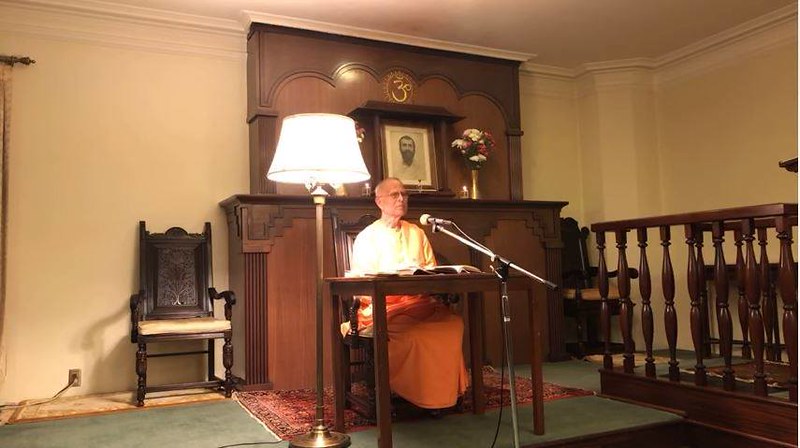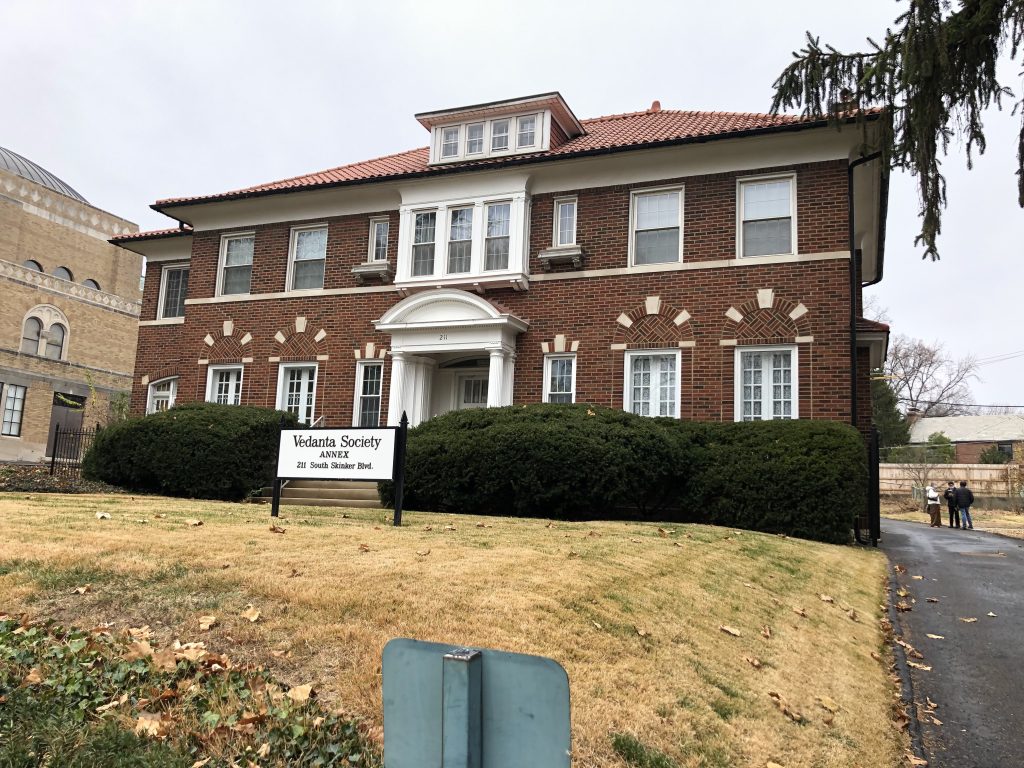
Swami Chetanananda, a monk in the Ramakrishna Order, has been serving as the Minister of the Vedanta Society of Kansas City and St. Louis, Missouri since 1950. He previously held positions in Advaita Ashrama’s publication and editorial departments.
He served as the Inter-Religious Council of Southern California’s Vice President and is currently a cabinet member of the Interfaith Partnership of St. Louis. In 1978, he moved to St. Louis, Missouri, where he worked as the Assistant Minister for the Vedanta Society. After Swami Satprakashananda’s death, he became the Society’s Minister in 1980. He also serves as the minister of the Kansas City Vedanta Society. His extensive spiritual experience inspired Kajingshai to interview him for publication in the Across Boundaries section.
VEDANTA IN THE WEST
KJ: Could you please share your experiences as a minister at the Vedanta Society of St. Louis and the activities of the centre?
SC: The Vedanta Society of St. Louis was started by Swami Satprakashananda, a disciple of Swami Brahmananda, in 1938. He was a very learned monk, and he met Holy Mother, Swami Vivekananda, and several direct disciples. The swami passed away in 1979.
I came to Hollywood in 1971 and worked with Swami Prabhavananda for five years. I was transferred to St. Louis in 1978 to assist Swami Satprakashananda, who was then bedridden. I lived with him for nearly two years.

Swami Vivekananda brought Vedanta (or Hinduism) to the West in 1893; later, five disciples of Ramakrishna came to the West to preach Vedanta. The teachings of Vedanta are very appealing to the American people, especially for two reasons. First, they love democracy, and the Vedantic concept of God is a democratic concept of God: each soul is divine. Second, they love freedom. It is as if the Statue of Liberty in the New York harbour is their chosen deity. The goal of Vedanta philosophy is jivan-mukti (“free while living”). Freedom is the song of the soul.
Ramakrishna monks have been spreading the messages of Vedanta and Ramakrishna in the West for the last 130 years. I have been working in this country for 52 years. Our St. Louis centre has various activities, such as daily worship and arati, lectures and classes, publications and a bookshop, interfaith meetings and interviews with students, and a spiritual ministry.
KJ: What are the Indian values that you believe should drive the 21st-century world? With technological advancements and Westernization, people seem to be drifting away from their culture, food, and traditions.
SC: India was under foreign rule for 1,000 years – Muslims ruled for 700 years; and the British, French, and Portuguese for a total of 300 years. Now India is a free nation and making tremendous progress in the fields of Economy and Technology. Behind all this spectacular progress, India should not forget her eternal values, which Swamiji reminded us of in his Lectures from Colombo to Almora. Material prosperity cannot bring peace and bliss in life; one cannot buy them in the market either. They come from spiritual life. Ramakrishna said that kamini-kanchan (lust and gold) cannot give happiness. This truth has been tested by many nations of the world, and some are now experimenting with it. India demonstrated the eternal values of renunciation and service in a changing society. Swamiji said that these are our national ideals: Renounce your ego and selfishness, and serve human beings as God. This is the religion of this age and the way one can find fulfillment in life. Swamiji said: They only live who live for others. I hope Indian people will listen to Swamiji and eventually will move in that direction.
When we study religion in the world, we find that the main focus in the 19th century was reasoning. People tried to understand God through reasoning. In the 20th century, the main focus of religion was humanism. People asked: If religion cannot bring happiness, what good is that religion? In the 21st century, I believe that the main focus of religion will be mysticism. People say that we have read enough, heard enough, and seen enough – now we want experience. In this context, Ramakrishna and our age-old Vedantic tradition will play an important role.
In 1992, I was invited by the School of Contemporary Mysticism in Avila, Spain, St. Teresa’s birthplace. I spoke on Ramakrishna’s spiritual experiences.
LIFE AND GOD
KJ: In the context of the Harmony of Religions, what universal moral ethics should every religion stress to maintain harmony in society?
SC: The seed of the harmony of religions is in the Rig Veda, Bhagavad Gita, and Shivamahimnah Stotra. But Sri Ramakrishna demonstrated that wonderful ideal in his life by practising Christianity and Islam along with Hinduism. He realized God in the Hindu way and then through other religions. No one, except for Sri Ramakrishna, has ever done that in the religious history of the world. His unique message was Jato mat tato path – as many faiths, so many paths. Do not quarrel about religion. Nowadays, we find that “Inter-religious Councils,” “Interfaith Partnerships,” and similar organizations are springing up in many cities in the Western world. This phenomenon started after the advent of Ramakrishna and after the Parliament of Religions at Chicago in 1893. In America, Swamiji gave a few lectures on ‘The Ideals of Universal Religion.’
I remember an incident that took place in St. Louis in 1980s. The local TV station interviewed me on Vedanta religion. The interviewer was Catholic. He asked me: “Swami, are the Hindu God, Christian God, Muslim God, and Jewish God different?”
I answered: “When the sun rises, can you say it a Hindu sun, Christian sun, Muslim sun, or Jewish sun? Can you put any stamp on the sun?”
The interviewer replied: “Swami, I have my answer.”
Swamiji spoke of universal moral ethics in his last lecture in the Parliament of Religions in Chicago in 1893:
The Christian is not to become a Hindu or a Buddhist, nor a Hindu or a Buddhist to become a Christian. But each must assimilate the spirit of the others and yet preserve his individuality and grow according to his own law of growth. In the face of this evidence, if anybody dreams of the exclusive survival of his own religion and the destruction of the others, I pity him from the bottom of my heart, and point out to him that upon the banner of every religion will soon be written, in spite of resistance: “Help and not Fight,” “Assimilation and not Destruction,” “Harmony and Peace and not Dissension.”
YOUTH AND SOCIETY
KJ: With growing wealth and prosperity in the middle class, many young people are skeptical about spiritual messages. They believe that unlike science, spiritual truths cannot be verified. How can they be convinced otherwise?
SC: It is true that nowadays the young generation are less interested in religion. In the West also, very few people go to church. Atheists, agnostics, and skeptics are not enemies of religion. They keep religion alive. They are true enemies of religion who are apathetic toward religion. Anyhow, when they are in trouble, they look upward and ask for help from God.
You see, Vedanta is a scientific religion. The method of science is experimentation, verification, and conclusion. Vedantic truths have been tested, verified, and then accepted. I think that those who complain against the Vedantic religion have never practised it.
There are two complains against Vedanta: first, it is dry; and second, it is difficult. You see, the subject matter of Vedanta is Satchidanada – existence, knowledge, and bliss. It is hard to believe that the blissful Brahman is dry. Those who complain that Vedanta is difficult, they never sincerely tried to understand this wonderful philosophy. If you want to get milk and kernel of the coconut, you will have to break the shell.
NORTH EAST INDIA AND SHILLONG
KJ: : RKM Shillong is fortunate to have had Revered Bhuteshanandaji Maharaj as the First Secretary, and several other great monks (such as Rev. Gahananandaji, Prameyanandaji and others) have contributed to the growth of the Shillong ashrama. Please share any reminiscences about RKM Shillong and your association with these monks.
SC: I have nothing to say at present.
RESEARCH AND NEW FINDINGS
KJ: Can you mention one incident from the recent discoveries about Swamiji’s travels/works?
SC: Some years ago, I got the script of Swamiji’s reminiscences by Mrs. Hansbrough from the Vedanta Society of San Francisco. I edited it and sent it to Prabuddha Bharata for publication. Then I translated it into Bengali, and this was published in Udbodhan magazine and later incorporated into Bahurupe Vivekananda. I found many interesting episodes concerning Swamiji in it, especially his human aspect. Let me tell you one incident.
Ralph was a son of Mrs. Wycoff, one of the Mead sisters who were devoted to Swamiji. He lived in their house in Pasadena for a few weeks in 1900. Ralph was then a teenaged boy and devoted to Swamiji.
One day Swamiji said: “Ralph, God is so near to us, but people do not see Him.”
Ralph: “Why, Swamiji?”
Swamiji: “You see everything with your eyes. Can you see your own eyes?”
Ralph: “No, Swamiji.” (After a pause) “But I can see my eyes in a mirror.”
Swamiji: “Ralph, that is the answer. If you have a pure, clean mind, you can see God right now.”
It is amazing that Swamiji did not quote any scripture or give a long talk to this American boy. He just convinced a young American by using a common example. Jesus said: “Blessed are the pure in heart for they shall see God.” It was said 2000 years ago and still it is a gospel truth. Our Upanishadic teachings are four to five thousand years old, still they are true. Truth never becomes old
Thank you,
Swami Chetanananda, Laguna Beach, California, 26. 8. 23
